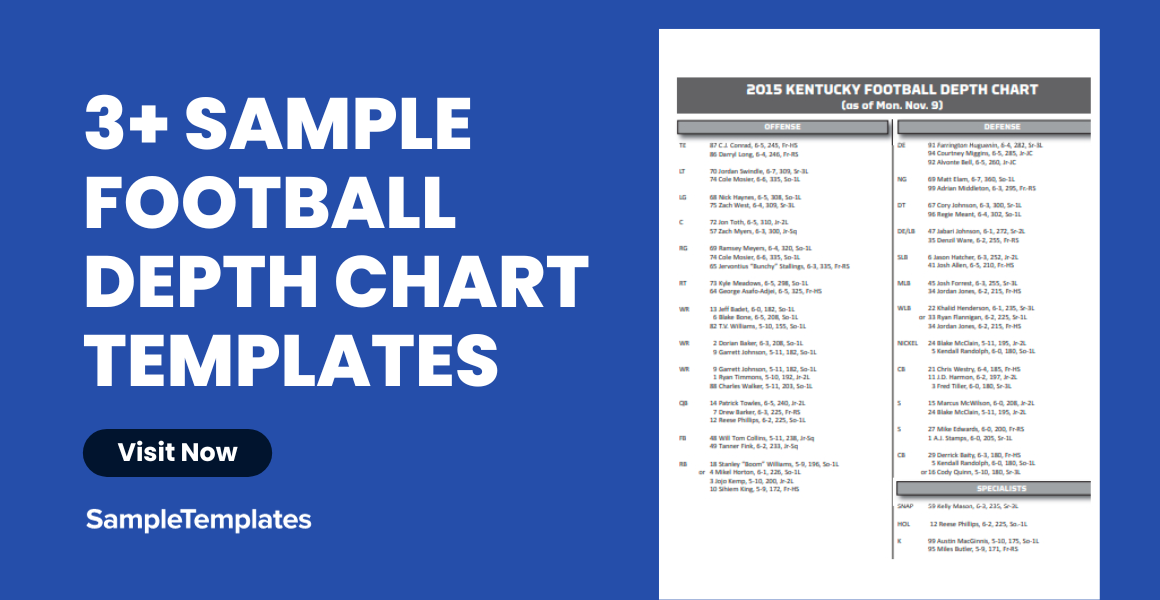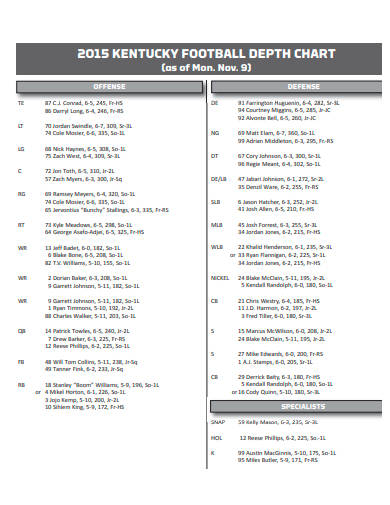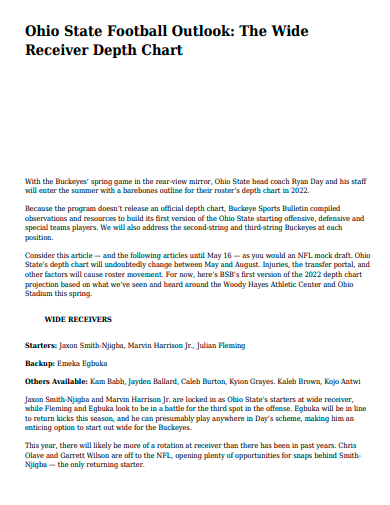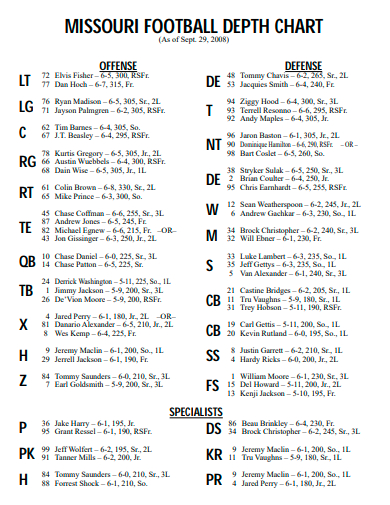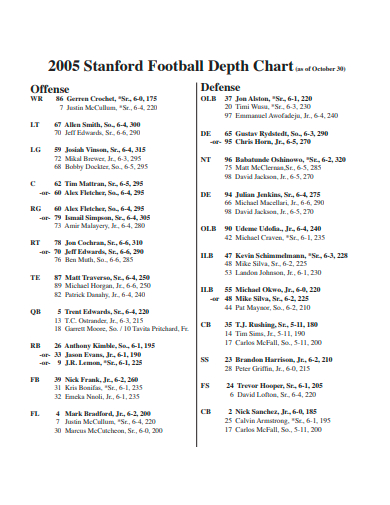Football is a game of strategy, and a key component of a successful football play is having a well-organized depth chart. A depth chart is a visual representation of a team’s roster plan, sorted by position and player ability, which helps the sports coaching proposal have informed decisions about the team’s playing time, substitutions, and overall game plan.
The depth chart is typically organized by position, with the starting player at the top of the list samples, followed by the second-string player, and so on. This allows coaches to see at a glance who the best player is at each position, and to plan for substitutions and rotations as necessary.
FREE 3+ Football Depth Chart Samples
1. Football Depth Chart Template
2. Football Receiver Depth Chart
3. Football Depth Chart Example
4. Standard Football Depth Chart
What is Football Depth Chart?
A football depth chart is a tool used by football teams to organize and plan their player rotations for game design proposal and practices. It’s essentially a roster that lists the team’s players by position and indicates which players are likely to start or see significant playing time in each game. Depth charts can vary by team and coaching staff, but they typically include multiple levels of players for each position. The top level usually consists of starters or players who are expected to see the most playing time, while the subsequent levels are typically made up of backups and reserves.
How To Make Football Depth Chart?
Creating a football depth charter samples can be a complex process, but it is an essential tool for any football coach looking to organize their team and make informed decisions about player rotations, substitutions, and overall game strategy. Here are the general steps for creating a football depth chart:
Step 1- Determine the Position
Start by identifying the different positions on your team. Depending on the level of football you are coaching, you may have different positions, but some common ones include quarterback, running back, wide receiver, tight end, offensive line, defensive line, linebacker, cornerback, and safety policy samples.
Step 2- Evaluate Your Players
Evaluate your players to determine who should be listed in each position group. Consider each player’s skill level, experience, and potential. Some key factors to consider include physical ability, technical training proposal, knowledge of the game, and work ethic.
Step 3- Determine Line-up
Once you have evaluated your players, you can determine the starting lineup for each position. The starting lineup is typically the most talented and experienced player at each position. Create a visual representation of your team’s depth chart, starting with the starting lineup for each position and listing backups and reserves below them. You can use a spreadsheet or a specialized software program to create the depth chart.
Step 4- Update Depth Chart Regularly
The depth chart is not set in stone and should be updated regularly. You can adjust the depth chart based on player performance, injuries, and other factors that may affect a player’s ability to contribute to the team. Once the depth chart is complete, communicate it to your team. Make sure they understand their roles and responsibilities sample and what they need to do to earn more playing time.
How is a depth chart organized?
A depth chart is typically organized by position, with the starting player at the top of the list, followed by the second-string player, and so on. This allows coaches to see at a glance who the best player is at each position, and to plan for substitutions and rotations as necessary.
How often is the depth chart updated?
The depth chart is updated regularly, often on a weekly basis. Coaches will adjust the depth chart based on player performance impact statement, injuries, and other factors that may affect a player’s ability to contribute to the team.
What happens if a player moves up or down the depth chart?
If a player moves up or down the depth chart, their playing time may change accordingly. A player who moves up the depth chart may earn more playing time, while a player who moves down the depth chart may see less playing time or be relegated to backup status.
Overall, the football depth chart is an essential tool for any successful football team. It provides coaches with valuable insights into their team’s strengths and weaknesses, helps players understand their roles, and allows for informed decisions about playing time, substitutions, and overall game strategy. By using the depth chart effectively, football teams can maximize their chances of success and achieve their goals both on and off the field.
Related Posts
FREE 10+ Pie Chart Samples in PDF
Free 3+ Eye Color Chart Samples in PDF
FREE 10+ Family Chore Chart Samples in PDF
FREE 10+ Classroom Chart Samples in PDF
FREE 10+ Genealogy Chart Samples in PDF
FREE 10+ Shipping Chart Samples in PDF
FREE 10+ Goal Chart Samples in PDF
FREE 10+ Character Chart Samples in PDF
FREE 10+ Table Seating Chart Samples in PDF
FREE 10+ Classroom Seating Chart Samples in PDF
FREE 10+ Grade Chart Samples in PDF
FREE 10+ Workflow Chart Samples in PDF
FREE 10+ Budget Chart Samples in PDF
FREE 10+ Process Flow Chart Samples in PDF
FREE 10+ Medication Chart Samples in PDF | DOC
